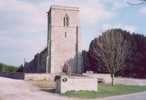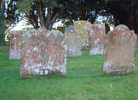 Sibthorpe Sibthorpe
St Peter
Churchyard
The churchyard surrounds the church, the bulk of it to the south. It is on
high ground overlooking the valley of the Car Dike. A semi-circle of 18 yew
trees to the west, south and east marks the boundary of the old churchyard
to the south of the church. There is one other yew near the porch and five
other trees among the tombstones. The Duke of Portland donated a piece of ground
to add to the churchyard in 1891and this lies beyond the line of trees. It
is maintained by the Parish Meeting.
A stone retaining wall approx 1.10m high runs around the churchyard to the
west, south and east and this was repaired in 1979 for £1800.
A road runs past the west end, a bungalow occupies land to the north and there
are fields to the south and east. A path leads from the road to an iron gate
in the churchyard wall west of the tower, continuing to the west door of the
tower and round the church to the south porch.
In a survey of 1987 there were 129 burials recorded by inscriptions. The oldest
stone was one found during the excavation of the nave floor; that of Robt 1719,
and Martha Atterby 1726.
The predominant families are Faulkes 14, 1735 to 1865, Fox 12, 1816 to 1932
and Hall 9, 1771 to 1923.
Average age at death where age is given: 53.
Oldest age at death: 96, Henry Fisher in 1871.
There is only one infant death of a child below 1 year (1825), and one aged
2 years (1907).
Throsby (1786-90) mentions a stone erected to the memory of four children
of the name of Hall, who died in infancy, at the foot of which are these lines:
The cup of life just with their lips they pressed,
They found it bitter and declined the rest.
Averse, then, turning from the face of day,
They softly sighed their little souls away |
There is no trace of it now.
The British Lichen Society has surveyed the churchyard for lichen, recording
40 different species.
In an adjoining field south east of the churchyard
is a C13 or C14 dovecote. It is 9.5m in diameter and 18.25m high, built of
stone with a conical roof. It contains 1260 nesting-places in 28 tiers.
 The
churchyard, looking south east from the church door The
churchyard, looking south east from the church door |
 Towards
the 14th Century dovecote, across the newer part of the churchyard and
the nearby earthworks. The top of the retaining wall is also visible. Towards
the 14th Century dovecote, across the newer part of the churchyard and
the nearby earthworks. The top of the retaining wall is also visible. |
 The
rich growth of lichens on some of the headstones The
rich growth of lichens on some of the headstones |
|